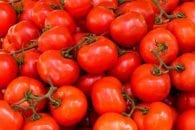Tomatoes make the “Top Twelve Foods” list, not only for their nutritional qualities, which are many, but because they are so versatile and they’re a kid favorite in ketchup and spaghetti and pizza sauce. While some green veggies rate higher on paper than red tomatoes, try getting a cup of kale into kids. Here’s why tomatoes are top:
Like that lycopene. The very nutrient that makes tomatoes red – lycopene – is also a top antioxidant. Even though beta carotene gets all the press as a health food, the most powerful cancer-kicking carotenoid is really lycopene. Lycopene delivers twice the antioxidant power of another top antioxidant, vitamin E. Yet, you’d have to eat a hundred times as many calories in vitamin E-containing foods to get the antioxidant power that’s in one tomato. Even though lycopene can help lower the risk of all cancers, research to date shows that tomato-based foods are most effective in lowering the risk of prostate cancer.
Tomatoes are usually picked when green, and as they ripen off the vine in transit to your home, they make more lycopene as they get riper and redder. While lycopene is found most abundantly in tomato products, it is also found in guava, watermelon, and pink grapefruit. The body absorbs more lycopene from tomatoes when they are cooked into sauce, paste, and salsa. Lycopene in canned tomatoes is even better absorbed than in raw ones. (This is one of the few foods in which man can do something to it to improve upon Mother Nature.) Tomato processing concentrates the amount of lycopene in the final product. For salad lovers, an additional nutriperk is a bit of oil eaten with the tomato pulls more of the lycopene out of the tomato and into the bloodstream. Cancer researchers believe that this combination is one of the reasons why people on the Mediterranean diet, which combines tomato products with olive oil, have one of the lowest rates of intestinal cancer and one of the longest lifespans.
Tomatoes are one of nature’s most nutrient-dense foods. Tomatoes are reported to contain around 4,000 phytonutrients, plant chemicals which pack powerful health properties. In addition to packing a powerful antioxidant profile, a tomato stores a lot of other good stuff in those pithy 26 calories, such as 1/2 gram of fiber, 25% of the RDA for vitamin A, a gram of protein, a bit of vitamin B6, riboflavin, niacin, almost half the RDA for vitamin C (high among veggies), and even a pinch of the minerals: zinc, iron, magnesium, manganese, and copper. It is even low in sodium and high in potassium, which is just what your body needs.
Tomato terms you should know (or may be curious about) Tomato puree is concentrated tomato juice and tomato pulp. If the tomato puree is seasoned, it’s called tomato sauce. If the puree is superconcentrated, it is known as tomato paste, which is an even richer source of nutrients such as beta carotene and iron. Sun-dried tomatoes are dehydrated tomatoes. They are sometimes packed in olive oil, both to preserve them and to enrich their flavor.
NUTRITIP: Better Ketchup
If your child is a ketchup addict, as most children are, replace the highly- sugared red stuff with healthier brands that are slightly sweetened with fruit concentrates. At least you’ll be getting more tomatoes than sugar. Even ketchups that tout “no refined sugars” contain around the same number of carbohydrates from added sweeteners, (such as pear or apple juice concentrate), as carbs from the original tomatoes. Ketchup can also be used in combination with other nutritious foods, such as a dip for veggies or as a sauce over whole- wheat pasta. So, a few added carbs are okay to sweeten the red stuff.
Also try ketch-oil. Mix a tablespoon of flax oil with three tablespoons of ketchup. Be sure to stir vigorously to mix the oil and ketchup. You can spread it on a sandwich or pour it into a bowl for dipping.

